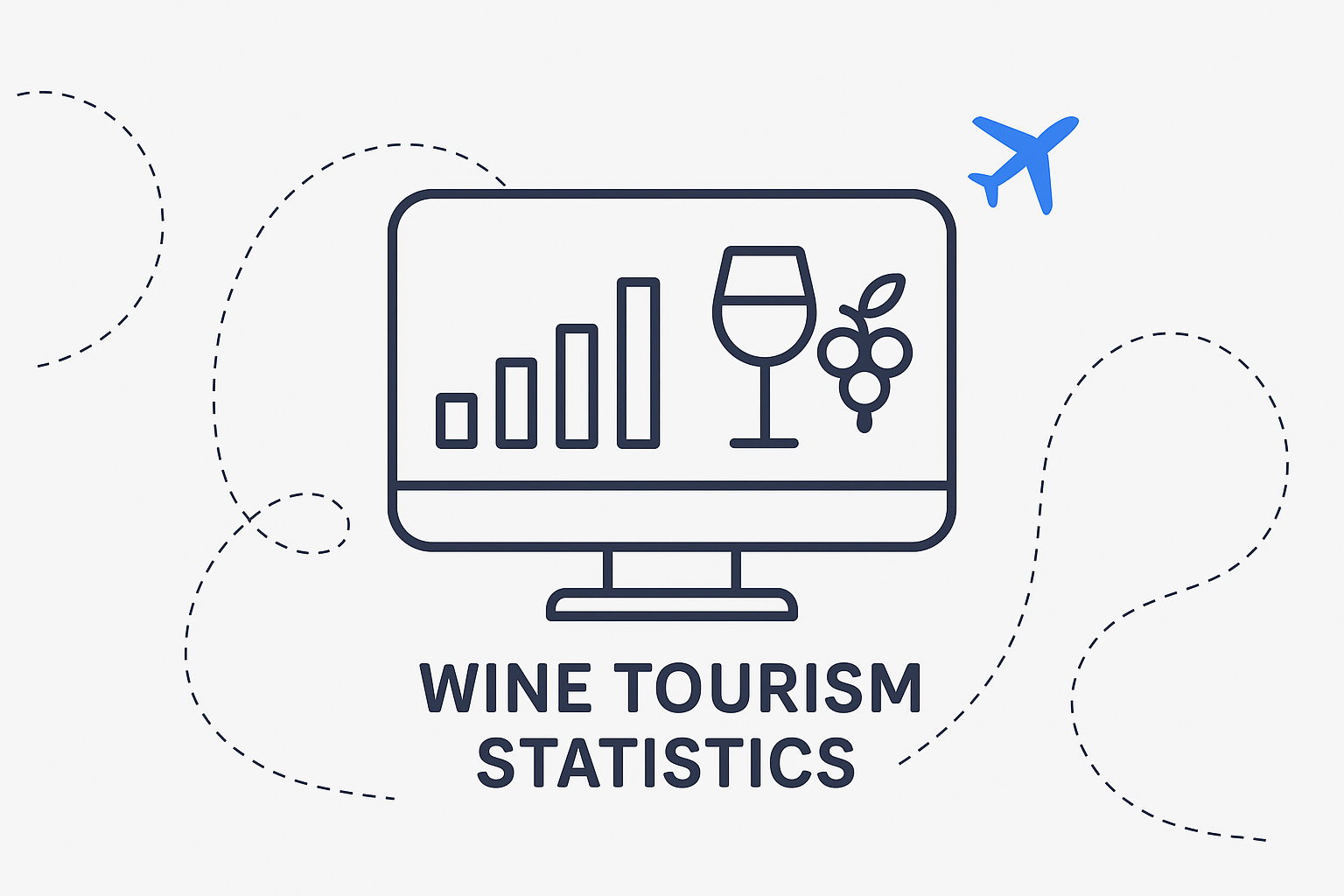Wine tourism — also called enotourism — has become a pillar of experiential travel. In value terms, the global wine tourism market reached USD 46.47 billion in 2023 and is on track to more than double to USD 106.74 billion by 2030 (CAGR 12.9%).
France alone welcomes around 10 million wine tourists per year, underlining how central vineyards and routes are to national and regional travel economies.
Beyond tastings, today’s wine trips bundle vineyard stays, food pairings, harvest experiences, and festivals.
What Are the Key Wine Tourism Statistics in 2025?
- The global wine tourism market is USD 46.47 billion (2023), projected to reach USD 106.74 billion by 2030 (CAGR 12.9%).
- Alternative long-horizon forecasts suggest growth from USD 46.5 billion (2023) to USD 160.7 billion (2033) (CAGR 13.2%).
- A 2025–2035 outlook places the market at USD 108.3 billion (2025), rising to USD 358.6 billion (2035) (CAGR 12.7%).
- France counts ~10 million wine tourists annually and ~€5.2 billion in income tied to wine tourism activities (literature review).
- Napa Valley (U.S.) drew 3.7 million visitors in 2023, with USD 2.5 billion in visitor spending and USD 107.5 million in local tax revenue (visitor profile & impact study).
How Fast Is the Wine Tourism Market Growing?
Analysts converge on double-digit annual growth driven by immersive, food-and-wine travel and destination investments.
Global Market Growth (Comparable Estimates)
| Source & Horizon | Base Year Value | Forecast & Year | CAGR |
|---|---|---|---|
| Grand View Research (to 2030) | USD 46.47B (2023) | USD 106.74B (2030) | 12.9% |
| Market.us (to 2033) | USD 46.5B (2023) | USD 160.7B (2033) | 13.2% |
| Future Market Insights (2025→2035) | USD 108.3B (2025) | USD 358.6B (2035) | 12.7% |
Grand View’s regional cut shows North America at USD 11.66 billion (2023) with 13.4% CAGR through 2030, and confirms tastings & tours as the leading service.
These ranges reflect methodology differences (scope, segmentation) but all point to sustained, robust expansion.
Who Are Wine Tourists in 2025?
While wine travelers span all ages, recent modeling indicates a strong showing among 30–40-year-olds (≈26.8%), and continued dominance of winery visits & tastings within the activity mix.
Wine Tourism Demographics (Selected Indicators)
| Indicator (Global/Modeled) | Share / Note |
|---|---|
| Age 30–40 cohort | ~26.8% of wine tourists |
| Leading activity | Winery visits & tastings (largest segment) |
Note: Demographic structures vary by country and route; always pair global signals with local data where possible.
How Much Do Wine Tourists Spend and What Is the Economic Impact?
Spending patterns are destination-specific, but mature regions show high per-visitor expenditure and strong tax capture:
- Napa Valley (2023): USD 2.5 billion visitor spending, USD 107.5 million in local tax revenue; average USD 281 per guest per day.
- In Napa’s 2022 accounting, wine retail embedded in tourism retail hit ~USD 829.7 million, ~33% of direct visitor spending; 79% of visitors went to wineries, typically 3+ per trip.
Destination Snapshots: Volume & Spend
| Destination | Latest Volume Indicator | Economic Indicator |
|---|---|---|
| France (national) | ~10 M wine tourists/yr | ~€5.2 B wine-tourism income (lit. review) |
| Napa Valley, USA | 3.7 M visitors (2023) | USD 2.5 B spend; USD 107.5 M tax |
| Wine Routes of Spain | 3,076,334 visits (2019) | €85 M+ spend (routes’ network) |
Which Wine Regions Lead as Travel Destinations?
Classic Old World regions (Bordeaux, Champagne, Burgundy; Tuscany & Piedmont; La Rioja & Catalonia) anchor Europe’s flow, while Napa & Sonoma headline the U.S. On route-based networks, Spain’s Wine Routes recorded 3.08 million winery/museum visits in 2019—useful as a pre-pandemic baseline for recovery tracking.
How Do Wine Tourists Travel and What Do They Book?
Across markets, tastings & tours dominate service mix; premium experiences (pairing menus, vineyard stays) are growing fastest. North America data confirms tastings/tours as the top revenue segment and the fastest-growing.
Are Sustainability and Well-Being Shaping Wine Tourism?
Eco-labels, organic/biodynamic practices, and biodiversity programs increasingly influence winery choice. While global, quantified adoption rates vary by study, France’s high route volumes and Spain’s route system illustrate how structured, local networks channel visitors toward sustainability-minded producers.
What Trends Will Shape Wine Tourism Next?
- Premiumization & immersion: longer stays, chef pairings, vineyard lodging.
- Structured routes & regional branding: national route networks (France, Spain) concentrate and measure impact.
- North American growth runway: double-digit CAGR and dominance of tastings/tours through 2030.
FAQ About Wine Tourism
How big is the wine tourism market right now?
Estimates put the market at USD 46–47 billion in 2023, with forecasts between USD 106–161 billion by 2030–2033 (≈13% CAGR).
Which country attracts the most wine tourists?
France is a perennial leader, with ~10 million wine tourists per year based on compiled national and academic data.
What’s a reliable indicator of economic impact?
Destination case studies: Napa Valley reported USD 2.5 billion in visitor spending and USD 107.5 million in local tax revenue in 2023.
Who is the core wine tourist?
Age mixes vary by region; one 2025 forecast attributes ~26.8% of travelers to the 30–40 cohort, with winery visits & tastings the dominant activity.
Which segments are growing fastest?
Tastings & tours lead globally; North America shows this segment as both the largest and fastest-growing through 2030.
Sources
- Grand View Research — Wine Tourism Market Size, Share & Trends
- Market.us — Wine Tourism Market to Reach USD 160.7 Billion by 2033
- Future Market Insights — Wine Tourism Market Size & Trends 2025–2035
- MDPI (Sustainability, 2025) — France’s Wine Tourism Scale (10M visitors; income estimates)
- Visit Napa Valley — Travel Research & Statistics (Visitor Spend, Tax, Volume)
- Visit Napa Valley (News, 2024) — 2023 Visitor Profile & Economic Impact Study
- MDPI (Economies, 2021) — Wine Routes of Spain: Visits & Spend Baseline
- Grand View Research — North America Wine Tourism Market Highlights
- Napa Valley Vintners (PDF) — Economic Impact of Napa County’s Wine & Grape Industry (Tourism Retail)



0 Comment